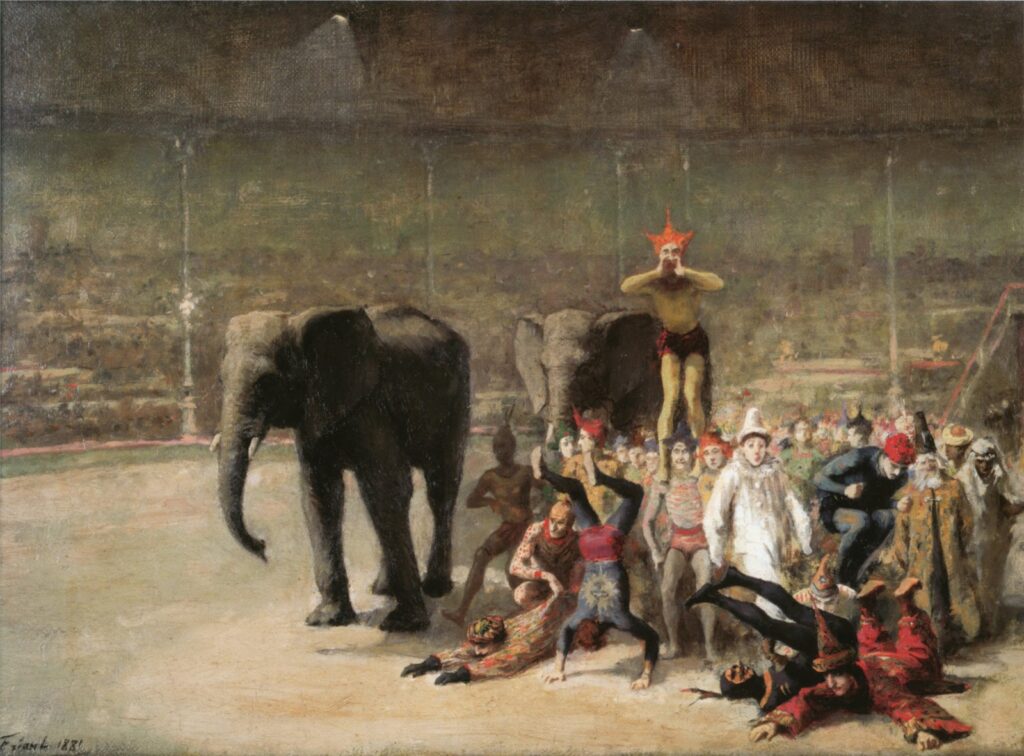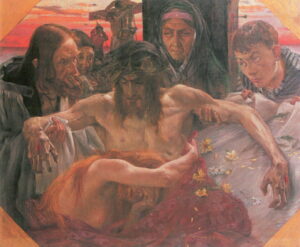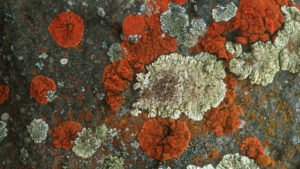Reading visual art: 136 Elephant

Of all the animals exotic to Europe, the elephant must have the longest and most distinguished history, including its depiction in paintings. Although the African elephant is now only found in sub-Saharan Africa, there was a North African species that became extinct in Roman times. The famous military elephants used by Hannibal in battle are believed to have been North African by species. Asian elephants were formerly found much further west and north than their current limited distribution, and ranged through coastal Iran, up through the Fertile Crescent into eastern Turkey. Europeans of the past thus had opportunities for contact with elephants from ancient times onwards.
It was the exploits of the Carthaginian general Hannibal and the eventual destruction of the empire and city of Carthage that have provided some of the best opportunities to see elephants in European paintings.
Jacopo Ripanda (fl 1500-1516), Hannibal Crossing the Alps (detail) (c 1510), fresco, dimensions not known, Palazzo del Campidoglio (Capitoline Museum), Rome, Italy. Image © José Luiz Bernardes Ribeiro / CC BY-SA 4.0, via Wikimedia Commons.
Jacopo Ripanda devoted an entire room of frescoes in the Palazzo del Campidoglio in Rome to the Carthaginians and the Punic Wars. Among them is this detail of Hannibal Crossing the Alps from about 1510.
Nicolas Poussin (attr) (1594–1665), Hannibal Crossing the Alps on Elephants (c 1625-26), oil on canvas, 100 x 133 cm, Private collection. Wikimedia Commons.
This canvas of Hannibal Crossing the Alps on Elephants has been attributed to Poussin, and dated to 1625-26, but is no longer considered to be by Poussin’s hand.
Hannibal’s moment of enduring fame came in the Second Punic War. During the late autumn of 218 BCE, he led his army of more than 20,000 infantry, 6,000 cavalry, and 37 elephants across the Alps. He caught the Romans near modern Turin where they were in winter quarters, and defeated them. It was the first step in a campaign which took him dangerously close to Rome itself.
Joseph Mallord William Turner (1775–1851), Snow Storm: Hannibal and his Army Crossing the Alps (1812), oil on canvas, 146 x 237.5 cm, The Tate Gallery (Turner Bequest 1856), London. Photographic Rights © Tate 2018, CC-BY-NC-ND 3.0 (Unported), https://www.tate.org.uk/art/artworks/turner-snow-storm-hannibal-and-his-army-crossing-the-alps-n00490
One of JMW Turner’s most radical early works, showing Snow Storm: Hannibal and his Army Crossing the Alps (1812), must have been influenced by the artist’s own firsthand experience of crossing Alpine passes. This is also radical in that the famous elephants are downplayed almost to the point of being invisible under Turner’s extraordinary storm sky. In fact, in the centre foreground, under a scarlet sheet, is what appears to be the black form of an elephant lying on the ground.
Cornelis Cort (1533–1578), The Battle of Zama (c 1570-1600), further details not known. Image by sailko, via Wikimedia Commons.
Between about 1570 and 1600, Cornelis Cort painted this magnificent work showing The Battle of Zama, which marked the last stage in the Second Punic War, in 202 BCE, in modern Tunisia. Contemporary accounts record that Hannibal here deployed no less than eighty of his war elephants, shown here with their wooden castles mounted. Despite opening the battle with a charge of these formidable animals, the Romans under Scipio Africanus dodged them, and went on to defeat the Carthaginians on their home ground.
Ferdinand Bol (1616–1680), The Fearlessness of Fabricius in the Camp of Pyrrhus (1655-56), oil on panel, 71 x 54.5 cm, Amsterdam Museum, Amsterdam, The Netherlands. Wikimedia Commons.
The Carthaginians under Hannibal were not the only army to use elephants in battle. Pyrrhus, the Greek King of Epirus, was loaned twenty elephants by Ptolemy II of Egypt for his invasion of Italy in 280 BCE, and they proved key to his defeat of the Romans at the Battle of Heraclea that year.
Pyrrhus also used his elephants on a more personal level. Before he was due to meet with the Roman Fabricius, the Greek general had one of them concealed behind a large drape near where he was to meet to speak with the Roman. When Pyrrhus gave the signal, the drape was removed, unveiling the huge elephant, which raised its trunk and emitted a fearful cry.
Ferdinand Bol painted a pair of works telling this story, the second of which is The Fearlessness of Fabricius in the Camp of Pyrrhus (1655-56) and shows the Roman turning calmly to Pyrrhus and telling him that neither gold nor the elephant made any impression on him.
Giulio Romano (1499–1546), Tribute to Apollo (1526-28), fresco, dimensions not known, Palazzo del Tè, Mantua, Italy. Wikimedia Commons.
Being an exotic and spectacularly large mammal, elephants were also included in depictions of triumphs and tributes, as in Giulio Romano’s fresco of a Tribute to Apollo from 1526-28, in the Palazzo del Tè, in Mantua, Italy. Some rather stranger and more mythical beasts are at the left in the far distance, but this artist appears to have been familiar with the characteristics of the elephant.
Charles Le Brun (1619–1690), Alexander Entering Babylon (1665), oil on canvas, 450 x 707 cm, Musée du Louvre, Paris. Wikimedia Commons.
As I mentioned at the start of this article, Asian elephants were found in the Fertile Crescent in the past. This is exemplified in Charles Le Brun’s painting of Alexander Entering Babylon from 1665. This shows the young Macedonian king riding in a large golden chariot hauled by a small elephant, as the great spoils of his early successes are being shown around them.
Lovis Corinth (1858–1925), The Temptation of St Anthony after Gustave Flaubert (1908), oil on canvas, 135.5 × 200.5 cm, The Tate Gallery (Presented by Erich Goeritz 1936), London. © The Tate Gallery and Photographic Rights © Tate (2016), CC-BY-NC-ND 3.0 (Unported), http://www.tate.org.uk/art/artworks/corinth-the-temptation-of-st-anthony-after-gustave-flaubert-n04831
Lovis Corinth’s painting of The Temptation of St Anthony after Gustave Flaubert in 1908 is his second of this motif, the previous work dating from 1897. This is based on Gustave Flaubert’s account La Tentation de Saint-Antoine, and focusses on a scene in which the Queen of Sheba appears in the saint’s visions. With her, as shown here, is a train consisting of an elephant, camels, and naked women riding piebald horses. Corinth’s Saint Anthony is a young man, and is surrounded by this outlandish circus of people and animals.
Paulus Potter (1625–1654), Orpheus and Animals (1650), oil on canvas, 67 x 89 cm, Rijksmuseum, Amsterdam. Wikimedia Commons.
Among the many superb animal paintings of Paulus Potter, Orpheus and Animals from 1650 is one of the most unusual, showing a wide range of different animal species, some of which weren’t well-known at that time, and one of which (the unicorn) didn’t even exist. Those seen include a Bactrian camel (two humps), donkey, cattle, ox, wild pig, sheep, dog, goat, rabbit, lions, dromedary (one hump), horse, elephant, snake, deer, unicorn, lizard, wolf, and monkey.
Émile Friant (1863–1932), The Entrance of the Clowns (1881), media and dimensions not known, Private collection. The Athenaeum.
One of Émile Friant’s earliest works is his 1881 painting of The Entrance of the Clowns, showing the interior of the Big Top at the moment that the clowns, acrobats, and captive elephants arrive. The artist has carefully put the foreground into relatively sharp focus and detail, and left the background blurred and sketchy, as may have been influenced by photographic depth of focus.
Briton Rivière (1840–1920) (attr), Tiger Hunt (date not known), oil on canvas, 121 x 108 cm, location not known. Wikimedia Commons.
Colonial powers also used elephants when hunting big game in countries like India, as seen in this painting attributed to the animal specialist Briton Rivière, Tiger Hunt.
My final elephant for today comes from the India of Gustave Moreau’s imagination.
Gustave Moreau (1826–1898), The Sacred Elephant (Péri) (1885-6), watercolour and gouache on paper, 57 x 43.5 cm, National Museum of Western Art 国立西洋美術館 (Kokuritsu seiyō bijutsukan), Tokyo, Japan. Wikimedia Commons.
The Sacred Elephant (Péri) (1885-6) is a magnificent watercolour showing Moreau’s best-developed painting of a thoroughly Indian motif. The Indian elephant has a long history as a sacred animal, at the heart of Hindu cosmology in supporting and guarding the earth (echoed by Terry Pratchett’s cosmic model of his Discworld).
Traditionally, the elephant is the mount (vāhana) for Lakshmi, Indra, Indrani (Shachi), and Brihaspati, all goddesses, apart from the last who is a sage. Indra’s mount is a white elephant named Airavata, and Indrani is the goddess of wrath and jealousy, so I suspect that Moreau intends the figure mounted on the elephant to represent Lakshmi, the Hindu goddess of wealth, fortune, and prosperity, and wife of Vishnu.
The elephant itself represents wisdom, divine knowledge, and royal power. It’s walking in a shallow lake rich in exotic vegetation, including lotus and lilies, as the sun is setting. Surrounding the mounted figure are four winged angelic creatures.



